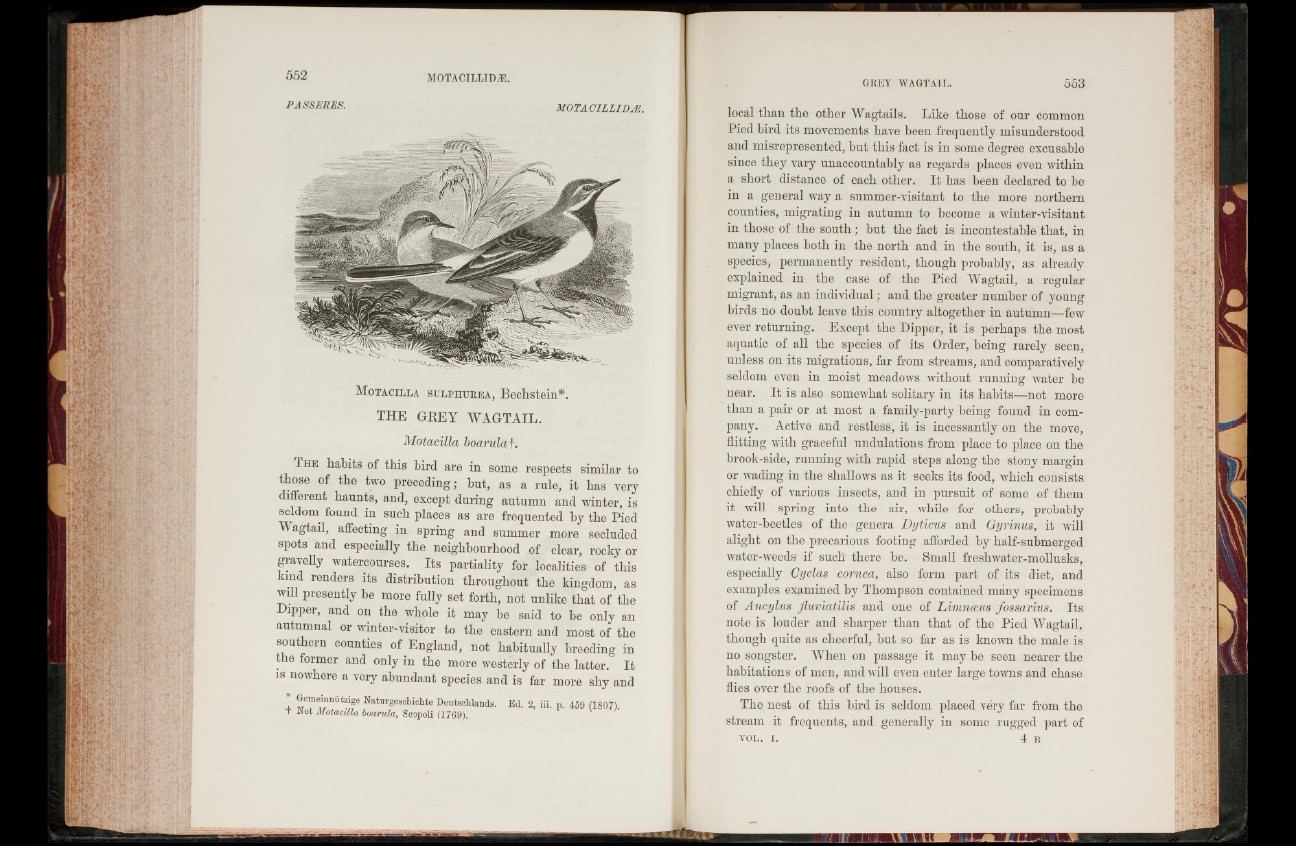
M o t a c il l a s u l p h u r e a , Bechstein*.
THE GBEY WAGTAIL.
Motacilla boarula\.
I h e habits of this bird are in some respects similar to
those of the two preceding; but, as a rule, it has very
different haunts, and, except during autumn and winter, is
seldom found in such places as are frequented by the Pied
W agtail, affecting in spring and summer more secluded
spots and especially the neighbourhood of clear, rocky or
gravelly watercourses. ^ Its partiality for localities of this
kind renders its distribution throughout the kingdom, as
will presently be more fully set forth, not unlike that of the
iPPer, an(l on the whole it may be said to be only an
autumnal or winter-visitor to the eastern and most of the
southern counties of England, not habitually breeding in
the former and only in the more westerly of the latter. It
is nowhere a very abundant species and is far more shy and
* Gemeinnützige Naturgeschichte Deutschlands. Ed. 2, iü. p. 459 (1807).
T Not Motacilla ioarula, Scopoli (1769).
local than the other Wagtails. Like those of our common
Pied bird its movements have been frequently misunderstood
and misrepresented, but this fact is in some degree excusable
since they vary unaccountably as regards places even within
a short distance of each other. I t has been declared to be
in a general way a summer-visitant to the more northern
counties, migrating in autumn to become a winter-visitant
in those of the south; but the fact is incontestable that, in
many places both in the north and in the south, it is, as a
species, permanently resident, though probably, as already
explained in the case of the Pied Wagtail, a regular
migrant, as an individual; and the greater number of young
birds no doubt leave this country altogether in autumn—few
ever returning. Except the Dipper, it is perhaps the most
aquatic of all the species of its Order, being rarely seen,
unless on its migrations, far from streams, and comparatively
seldom even in moist meadows without running water be
near. It is also somewhat solitary in its habits—not more
than a pair or at most a family-party being found in company.
Active and restless, it is incessantly on the move,
flitting with graceful undulations from place to place on the
brook-side, running with rapid steps along the stony margin
or wading in the shallows as it seeks its food, which consists
chiefly of various insects, and in pursuit of some of them
it will spring into the air, while for others, probably
water-beetles of the genera Dyticus and Gyrinus, it will
alight on the precarious footing afforded by half-submerged
water-weeds if such there be. Small freshwater-mollusks,
especially Gyclas cornea, also form part of its diet, and
examples examined by Thompson contained many specimens
of Ancylus fluviatilis and one of Limnceus fossarius. Its
note is louder and sharper than that of the Pied Wagtail,
though quite as cheerful, but so far as is known the male is
no songster. When on passage it may be seen nearer the
habitations of men, and will even enter large towns and chase
flies over the roofs of the houses.
The nest of this bird is seldom placed very far from the
stream it frequents, and generally in some rugged part of
v o l . i . 4 b